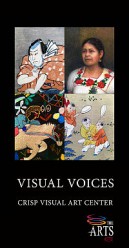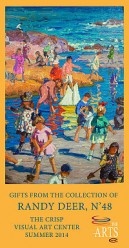 CULVER, Ind. — The Crisp Visual Art Center at the Culver Academies is pleased to announce three outstanding exhibitions for summer 2014: Visual Voices, Gifts from the Collection of Randy Deer N’48, and a Time of Malfeasance.
CULVER, Ind. — The Crisp Visual Art Center at the Culver Academies is pleased to announce three outstanding exhibitions for summer 2014: Visual Voices, Gifts from the Collection of Randy Deer N’48, and a Time of Malfeasance.
The Crisp Visual Art Center is located on Academy Road near Logansport Gate on the Culver Academies campus. The galleries are open to the public from 1 to 4 p.m. on Saturday and Sunday, June 22 through Aug. 9. Weekday appointments by individuals or groups may be arranged by calling curator Robert Nowalk at (574) 842-8278 or through e-mail at Robert.nowalk@culver.org.
 Visual Voices, in the Wolfe Gallery, includes work from both the Academies’ and private collections. The exhibition, aligned with the teaching mission of the Crisp Visual Art Center, begins by asking the viewer to consider the ties that “bind all human culture” and the common “threads that weave the fabric of humanity.” What follows are paintings, drawings, sculptures, and artifacts from various cultures in Asia, Africa, and the Americas. The astute viewer will discover that the overall theme addresses the human propensity to engage in play, whether seen in the festival paintings of contemporary Mexico, the theatrical woodcuts of 19th century Japan, or the dance moccasins of the Sioux and Blackfeet tribes. Even the oldest work in the exhibition, a Chinese coin from 1st century A.D., has a playful design stamped across its double-footed spade shape. Overall the exhibition has many riches that are well worth an extended visit.
Visual Voices, in the Wolfe Gallery, includes work from both the Academies’ and private collections. The exhibition, aligned with the teaching mission of the Crisp Visual Art Center, begins by asking the viewer to consider the ties that “bind all human culture” and the common “threads that weave the fabric of humanity.” What follows are paintings, drawings, sculptures, and artifacts from various cultures in Asia, Africa, and the Americas. The astute viewer will discover that the overall theme addresses the human propensity to engage in play, whether seen in the festival paintings of contemporary Mexico, the theatrical woodcuts of 19th century Japan, or the dance moccasins of the Sioux and Blackfeet tribes. Even the oldest work in the exhibition, a Chinese coin from 1st century A.D., has a playful design stamped across its double-footed spade shape. Overall the exhibition has many riches that are well worth an extended visit.
 On exhibit in the Deer-Zink Gallery is a selection of paintings given by Indianapolis resident Randy Deer who graduated from Culver’s Summer Naval School in 1948. Gifts from the Collection of Randy Deer N’48 consists of 15 paintings ranging from a delicate 18th century gouache by August Querfurt of Austria to two modern landscapes by American painter Laurence P. Sisson. The exhibition allows the viewer to enjoy Culver Academies’ only examples of French, English, and American Impressionism as well as several rarely seen works by the American expatriate painter, William Samuel Horton. Horton, who was born in Grand Rapids, Mich., in 1865, moved to England after being rejected by his family for wanting to pursue the life of a painter. Though represented in various European collections, Horton only became known in America three decades after his death in 1936 when two American collectors convinced his sole heir to part with the remaining work in his estate. The three works by Horton are strong examples of American involvement in post-Impressionist practices and alone are worth the visit to the Crisp Visual Art Center.
On exhibit in the Deer-Zink Gallery is a selection of paintings given by Indianapolis resident Randy Deer who graduated from Culver’s Summer Naval School in 1948. Gifts from the Collection of Randy Deer N’48 consists of 15 paintings ranging from a delicate 18th century gouache by August Querfurt of Austria to two modern landscapes by American painter Laurence P. Sisson. The exhibition allows the viewer to enjoy Culver Academies’ only examples of French, English, and American Impressionism as well as several rarely seen works by the American expatriate painter, William Samuel Horton. Horton, who was born in Grand Rapids, Mich., in 1865, moved to England after being rejected by his family for wanting to pursue the life of a painter. Though represented in various European collections, Horton only became known in America three decades after his death in 1936 when two American collectors convinced his sole heir to part with the remaining work in his estate. The three works by Horton are strong examples of American involvement in post-Impressionist practices and alone are worth the visit to the Crisp Visual Art Center.
Summer allows the Crisp Visual Art Center to move work from the permanent collection into the second-floor student gallery and the show, A Time of Malfeasance, devotes the space to one suite of engravings that is both captivating and, despite its impetus, timeless. Printmaker Virginia Myers, like many Americans, was drawn into the drama that unfolded as the Watergate Hearings began broadcast in 1973. Always the artist, Myers recorded her emotional reaction in a series of self-portraits which eventually expanded to a 21-plate suite of engravings.
Throughout the series, the artist reflects the complex weave of emotions shared by so many Americans at that time. There are moments when the artist simply stares into space, as if belief in the events of the day were inconceivable. We see her as judge, prophet, angered by many voices, stunned by admissions, descending into darkness, and reaching for some sense of hope in the whirlwind of controversy. To view the entire series with knowledge of its original impetuous is to experience this time through the eyes of the artist. The technical tour de force across the series extends the impact of each work for all of these plates were hand wrought, the images being scratched and scraped with burin and needle into copper plates. Culver Academies includes, here, one historical document which brings home the importance of these works: a signed copy of President Nixon’s letter of resignation to then Secretary of State Dr. Henry Kissinger. Part of Culver’s Signature Collection, the letter reminds us of events that occurred just 40 years ago this August and the courage of those American’s who worked to re-enforce the fabric of American democracy for the good of the people.
About Culver Academies
Located on Lake Maxinkuckee in Culver, Ind., Culver Academies is a boarding school offering a college-preparatory curriculum for boys and girls in grades nine through 12.
In 2013-14, Culver had an enrollment of 810 students representing 38 states, the District of Columbia, and 23 countries. Approximately 20 percent of the students are international, coming from such countries as Canada, China, Ecuador, Guatemala, Korea, Mexico, Saudi Arabia, Spain, Taiwan, and the United Kingdom.
Culver’s mission is to educate its students for leadership and responsible citizenship by developing and nurturing the whole individual through integrated programs that emphasize the cultivation of character.
Founded in 1894, the boys’ school, Culver Military Academy, is based upon a military-type system used to teach self-discipline, responsibility, and leadership. Culver Girls Academy, founded in 1971, and is based upon the prefect system, with girls practicing democratic self-rule to achieve similar values.
The Academies and the six-week Culver Summer Schools & Camps, with an enrollment of 1,400 for boys and girls ages 9-17, operate on the same 1,800-acre campus in Marshall County in north-central Indiana.
For more information, visit www.culver.org.














